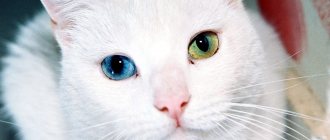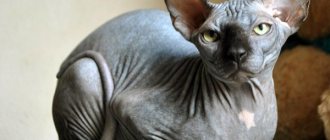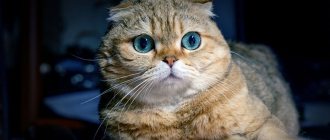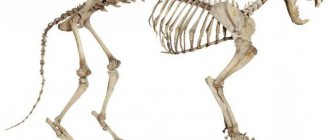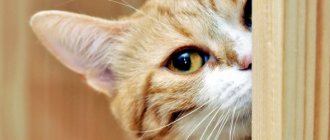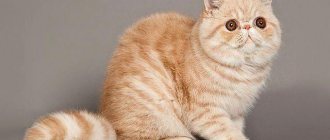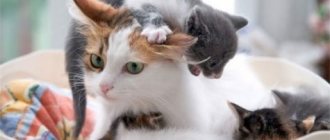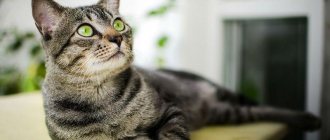The long-haired cat is a sensational cat! It was presented to pampered Europe in the 16th century by aristocrat Pietro della Valle. The famous traveler took a couple of long-haired beauties from Persia and presented them to the Pope. The Supreme Pontiff was the first to fall under the Persian spell, and after him the rest of the Italians fell, and then the French.
Historically, oriental beauties immediately fell under the patronage of noble persons. And if in Italy long-haired cat breeds conquered the Pope, then in France they lived at the court of Cardinal Richelieu. Oh, how many small and big secrets of the world behind the scenes have been seen by cats with long hair! But long-haired cat breeds are not known for being talkative, and the domestic aristocrat remains a reliable keeper of secrets.
At the same time, many note that long-haired cats are much more affectionate than their short-haired friends. They are literally created for an apartment or a house, but in their affections, they still give first place to people. For children, and for adults too, long-haired cats are ideal companions!
We will talk about the main long-haired representatives in this material.
Breeds of long-haired cats
Which breeds are considered traditionally longhaired:
- Persian cat;
- Maine Coons;
- Burmese;
- Angora;
- Siberian cats;
- Neva Masquerade;
- ragdoll;
- Norwegian forest
Short-haired cats are more numerous. The gene responsible for long hair is recessive, and the gene for short hair is dominant. This means that for a cat to be longhaired, it must have 2 longhair genes. With one longhair gene and one shorthair gene, the cat will be shorthaired. However, if there is a gene for long hair in a breed, then it is constantly passed on to the offspring. Therefore, even several generations of short-haired cats can produce long-haired offspring.
Thanks to this, for example, in the litters of true British Shorthairs there were longhaired kittens, which today are identified as a separate breed of British Longhairs. Or the American Curl, for example, has both short-haired and long-haired representatives. The International Cat Federation has recognized 2 varieties of the breed as separate: ACL - American Curl Longhair and ACX - American Curl Shorthair.
Varieties of color
Felinologists have identified three tricolor varieties:
- Scaly (may be called torti) - here the black and orange colors are layered on top of each other without forming a clear pattern. Looks like scales. One color prevails over the other.
- The color of the calico is black and red with red (orange) spots distributed throughout the body. There may also be yellow with a honey tint, red with brick, and shades of gray.
- Harlequin - the main color is white, the other colors occupy only a sixth of the surface of the fur (see photo). At the same time, the colored spots have clear outlines, they are not blurred, like those of a calico. Harlequins have a white belly and a back covered with bright, clear black and red spots, or the animal is entirely white with colored ears, a tail, and “socks” on its paws.
Prices for cats
Prices for longhaired cats vary depending on where you buy them and their pedigree. Of course, cats with pedigrees are much more expensive than just ordinary long-haired pets. It is better to buy a kitten from a nursery, where it will be given the necessary vaccinations and checked for serious diseases. However, you can adopt a good pet for your family free of charge through an advertisement and then bring it to the clinic for examination and vaccination.
The most expensive long-haired breeds are:
American Curls are a very rare breed, with a kitten costing between $1,000 and $3,000.
Laperm long-haired - a rare curly-haired cat will cost $200-2000.
Maine Coon - a wonderful warbler cat will cost between 600-1,500 dollars.
Highland Fold (Scottish Fold Longhair) will also cost between 200-1500 dollars.
A Himalayan cat will cost the owner 500-1300 USD.
Himalayan cat
Interesting Facts
For lovers of colorful pets, the following information will be useful:
- according to statistics, there are 3000 times more meowing ladies with three colors on the planet than seals of the same color;
- in Japan, figurines of tricolor cats are placed at the entrance to homes, near markets and restaurants to attract good luck and material well-being;
- There is a custom among sailors to take the tricolor on board to avoid shipwreck.
Maybe you shouldn’t attach too much importance to your pet’s color, much less endow it with magical properties based on this characteristic. The main thing is love for the small harmonious creature. Any kitten, regardless of color, can bring joy and a smile to life.
How to choose a kitten
When choosing your future pet, look for an active, playful, curious baby. Give the kittens a ball or a bow and watch their reaction. When walking, the cat's head should be raised. It will not be difficult for a healthy kitten to jump from the seat of a chair to the floor. It is better not to take a passive animal, this may be a sign of some kind of disease.
Make sure the fur is soft. Kittens of some breeds may not have particularly long hair at first, but it will grow over time. If possible, look at the baby's parents. Pick it up and pet it. The spine and joints should not stand out under the palm. The kitten should not limp.
Touch the belly of your future pet - it should not be swollen (this is a sign of gastritis). Examine your future pet from behind under the tail - around the anus should be clean and there should be no signs of diarrhea.
Carefully examine the head and face of the selected pet. The eyes should be clean, clear, not watery, and there should be no pus in them. The kitten should not sniffle, sneeze, or runny nose. All these could be symptoms of acute respiratory infections. There should be no dark wax in the ears.
Observe the kitten - he should not shake his head or try to scratch his paws (this could be a sign of ear mites). Carefully open your mouth - the gums and oral cavity should be pink, the teeth should be clean and white.
Neva Masquerade
Russian blue
A slender, muscular cat of medium size, on high legs, with a proportional wedge-shaped head and high-set ears. The calling card of the breed is its unique color, blue with silver tipping (lightened hair tips). It feels like the cat's coat is dusted with snow. She looks absolutely stunning with bright green eyes! The coat of Russian Blues is short and very thick - according to the standard, the hairs should be located vertically to the skin.
The history of the breed (like many other old breeds) is complex and somewhat confusing. But it is known that neither Russians nor modern Russian breeders have anything to do with its creation. These cats were bred at the beginning of the last century in Great Britain - based on animals imported from Arkhangelsk. At least that's what the most common version says. However, cats from other regions and representatives of other breeds were also involved in selection.
Kitten adaptation
After you bring your pet home in a carrier, leave it in it for a while. The kid must get out of the shelter himself and explore the surroundings. And only after he gets used to it a little can he be given a treat. During the adaptation period, there is no need to invite strangers into the house, make loud noises, make sudden movements or scare the kitten. The owner of the kitten should try to be at home more often during this period, not leave it alone, pet it and show all sorts of signs of attention.
When a cat appears in the house, you need to provide it with the safest living space possible. Always check the washing machine before turning it on to make sure your cat doesn't sleep in it. Close the door to the kitchen while cooking to prevent your pet from burning its fur.
Particular attention should be paid to windows. In the summer, when the windows are opened wide, measures should be taken to prevent the pet from falling out of the window - anti-cat nets are installed for this purpose. Use vertical ventilation mode with caution. Quite often there are cases when curious pets tried to get out of a half-open window and got stuck in the sashes.
Norwegian Forest Cat
Features of feeding
The diet of long-haired cats should be balanced. Since the hair of long-haired cats, when it gets into the stomach when licked, is more difficult to remove, it is better to feed your pet with specialized ready-made food that contains a component that helps eliminate hairballs from the body.
There is the so-called Big Five manufacturers of high-quality feed, which have their own research centers to improve the quality of their products. These are American, Diamand. Also considered one of the best are foods from Canada: Acana and Orijen. They produce specialized lines of food for long-haired cats, taking into account their physiological state: for kittens, for cats over 7 years old, for pregnant cats.
The pet can be fed with both dry and canned food. If a cat is fed only dry food, then water must always be freely available. If he is accustomed to both foods, then the best feed ratio is 75% dry food and 25% canned food.
You can feed once a day or 2 times a day. Some practice free access to food. In this case, you need to keep an eye on your pet so that it does not overeat. The energy value and the calculation of the amount of food depending on the weight of the pet are usually written on the food packaging. A bowl of green grass, the seeds of which can be bought at every pet store, would be useful. Green grass is a source of vitamins, fiber and folic acid. The herb also helps remove hairballs that your cat may have swallowed while licking its fur.
Siberian cat
Features of caring for long-haired cats
When caring for long-haired breeds, taking care of your pet’s coat takes a special place. Each breed requires its own special approach. For example, Persians and Burmese longhair cats need to be combed every day with several types of combs using special products. Other breeds only need brushing 2-3 times a week.
How often a cat needs to be brushed depends on the length, thickness, and texture of the coat and undercoat. Cats with a soft undercoat need to be brushed 2-3 times a week to prevent the hair from matting. Brushing helps remove dead hair, which in nature cats usually lick.
Such licked hairs can form a hair ball in the pet's stomach. Brushing also stimulates blood circulation, removes dead skin cells, and tones muscles. Thanks to grooming, you can detect various diseases on your cat’s body at an early stage.
Without proper care, your pet's fur will quickly become tangled and untidy, matted tangles will appear. Therefore, it is very important to accustom your long-haired pet to combing from the first month of life, or at least from the beginning of his stay in the house.
To care for your pet's fur you will need several types of combs:
- with sparse and long teeth;
- with medium teeth;
- with short and frequent teeth;
- brush with bristles.
Combs should have non-sharp, rounded teeth that will not damage your pet’s skin or cause him pain. First you need to carefully untangle the tangles using a special spray. Then use a wide-toothed comb to comb the fur in the direction of its growth. All movements must be done very carefully so that the kitten enjoys combing.
You can buy a special pet product at the pet store to make combing easier. Then change the comb to a tool with more frequent teeth. When finished brushing, run a natural bristle brush through the coat. If you do everything correctly, the baby will soon fall in love with the ritual of brushing and you will not have any problems. Complete the procedure with a game and combing will become his favorite pastime.
To keep the fur long, healthy and shiny, follow your pet’s diet. It is better to use ready-made balanced food from well-known manufacturers who have special lines for long-haired breeds, which include special components for expelling hairballs from the stomach and a full set of vitamins to keep your pet healthy. The pet has a seasonal shedding 2 times a year.
Highland fold
Pet examination
Periodically, the owner of a long-haired pet should examine it in order to identify possible diseases at an early stage:
- The cat’s nose should be wet: a dry nose is a sign of high fever and a reason to urgently contact a veterinarian;
- discharge from the genitals and anus may be the first sign of various inflammations;
- if the cat walks outside, you should inspect the paw pads for damage;
- A nursing cat's nipples should be examined. If they are inflamed, massage may help. However, in this case it is better to contact a veterinarian, otherwise the cat may refuse to feed the cubs;
- Monitoring the condition of the ears is important - they should be pink and clean. If wax accumulates, clean the ears with cotton swabs soaked in petroleum jelly. You cannot wash your ears with water. For anti-mite prevention, ears can be sprinkled with antiseptic powder.
Water treatments
Long-haired pets should be bathed weekly only when they take part in exhibitions. If the pet is domestic, he takes care of his fur himself. When a cat licks its fur, it distributes secretions from the skin glands, which make the coat waterproof and warm.
Washing is necessary only once a month or when the pet comes home too dirty. A dirty cat needs to be washed and dried. Bathing will not rid the animal of mats and parasites.
Nail trimming
A cat needs to have its claws trimmed only in limited cases: if its paw is in a cast or has been motionless for a long time, or if an old cat cannot take care of itself. Claws should only be trimmed if you have experience in this matter, so as not to damage the claw bed, which is rich in blood vessels. If you have no experience, it is better to consult a veterinarian.
Folk signs
In Rus', many signs have been formed from folk beliefs about tricolor cats. Here are some of them:
- the cat washes against the grain - you should wait for the weather to worsen;
- when stretching, the animal looks towards the person - he should receive good news;
- the approach of someone else's tricolor to the house is a sign of good changes;
- a tricolor cat protects its owner from illness;
- The blue-eyed pestle protects the family from an envious eye, slander, and failure.

